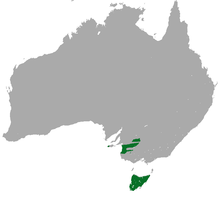Dwarf bilchbeutler
| Dwarf bilchbeutler | ||||||||||||
|---|---|---|---|---|---|---|---|---|---|---|---|---|
| Systematics | ||||||||||||
|
||||||||||||
| Scientific name | ||||||||||||
| Cercartetus lepidus | ||||||||||||
| ( Thomas , 1888) |
The dwarf bilchbuckle ( Cercartetus lepidus ), also known as the Tasmanian sleeping bag , occurs in southeastern Australia (western Victoria to southeastern South Australia ), on Tasmania and on the kangaroo island. The population on mainland Australia was not discovered until the 1960s and may need to be classified as a separate species.
Appearance
The dwarf bilchbeutler is one of the smallest representatives of the marsupials with a body length of 5.0 to 7.3 centimeters, a tail length of 6.0 to 7.5 centimeters and a weight of 6 to 10 grams . The eyes are large, the muzzle is short, and the ears are rounded. The fur is gray-brown on the back, the belly is gray. The gray color of the abdomen distinguishes the Zwergbilchbeutler from all other types of sleeping bag, especially the thin-tailed sleeping bag ( Cercartetus concinnus ), which has a white stomach. The long-tailed sleeping bag ( C. caudatus ) has a longer tail than the dwarf billy and the thick-tailed sleeping bag ( C. nanus ) differs from the dwarf billy because of its small size and the presence of a fourth molar in the upper and lower jaw.
Way of life
Dwarf bilchbeutler occur in dry forests and heaths, on the mainland also in the Mallee , on the kangaroo island and on Tasmania also in hard deciduous forests , but not in rainforests or in Tasmania in alpine treeless or tree-covered areas. In the habitat are eucalyptus , acacia , banksia , bottlebrush , callitris , Hakea - and Leptospermum TYPES and Myrtenheiden ago. Dwarf bilchbeutler are nocturnal and spend the day in self-made nests and in bird nests, in tree hollows, under tree stumps or large tufts of prickly head grass , behind loose pieces of bark, in the crowns of grass trees or between the dried-up inflorescences of banksia. They are very agile and good climbers who look for their food both in the undergrowth and on high treetops. Dwarf bilchbuckler feed on insects, nectar and pollen. The uptake of nectar and pollen was observed in Banksias, Eucalyptus, Astroloma and Leptospermum species.
In the colder months of the year, the animals often fall asleep ( torpor ), in which the body temperature drops and the uptake of oxygen falls to up to 1 percent of the normal value.
Reproduction
Dwarf bilchbeutler reproduce in mainland Australia year-round, with the highest birth rate in late southern winter. In Tasmania, they reproduce in spring and summer. The different breeding times could correlate with the food supply in the respective season. Usually two to four young animals are born, in rare cases more, a maximum of eight. The young animals leave the pouch around 42 days after birth and are weaned at around 90 days of age.
Hazards and protective measures
The main threats of this species include bushfires, the conversion of their habitat to pastures, and the pursuit of feral dogs and domestic cats. Since this species is still relatively common and also occurs in protected areas, the IUCN classifies it in the “ Least Concern ” category .
Individual evidence
- ↑ a b c d Stephen Jackson: Family Burramyidae (Pygmy Possums). In: Don E. Wilson , Russell A. Mittermeier : Handbook of the Mammals of the World - Volume 5. Monotremes and Marsupials. Lynx Editions, 2015, ISBN 978-84-96553-99-6 , p. 454.
- ^ F. Geiser: Hibernation and Daily Torpor in Two Pygmy Possums ( Cercartetus Spp., Marsupialia) . In: Physiological Zoology . 60, No. 1, 1987, pp. 93-102. JSTOR 30158631 .
- ↑ Cercartetus lepidus in the IUCN Red List of Threatened Species 2014.3. Posted by: Menkhorst, P., 2008. Retrieved November 16, 2014.
